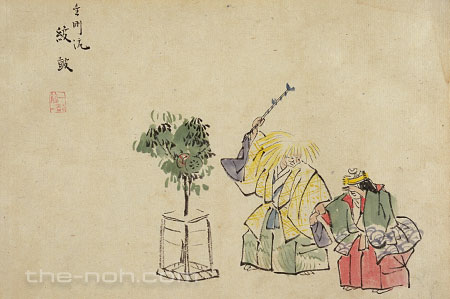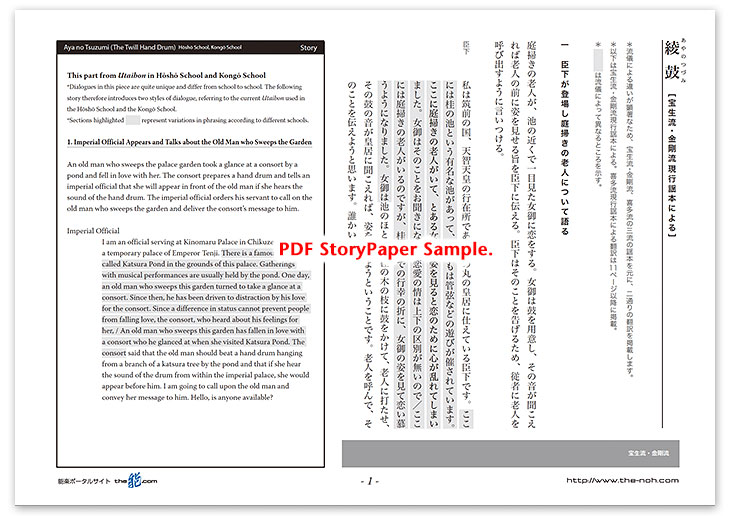
 Aya no Tsuzumi (The Twill Hand Drum)
Aya no Tsuzumi (The Twill Hand Drum)

![]()
It happened in the time of Emperor Tenji (the 7th century), at the Katsura Pond located in the grounds of a temporary palace called Kinomaru in Chikuzen Province (present-day Fukuoka Prefecture). An old man who sweeps the floor of the palace garden happened to take a glance at a consort and fell in love with her. An imperial official orders his servant to deliver a message from the consort to the old man, saying that she will appear before him if she hears the sound of a hand drum hanging from a branch of a katsura tree (Cercidiphyllum japonicum) that grows beside the pond. The old man keeps hitting the hand drum and tries hard to make it sound, but the hand drum never does so because its head is made of a twill fabric. Suffering from distress, the old man leaps into the pond and drowns himself.
Hearing from his servant that the old man has drowned himself, the imperial official tells the news to the consort. As the consort starts to hear the sound of the hand drum coming from the pond, she looks as though she is losing her mind.
Then, from the bottom of the pond emerges the ghost of the old man. He now looks like a demon and attacks the consort. Brandishing a whip, he orders the consort to make a sound with the twill hand drum. However, the drum never makes a sound. Having taught the consort a lesson in karmic retribution, he vanishes into the pond, to the very end voicing his feelings of bitterness toward her.
![]()
The central focus of this play is an old man’s love that results in tragedy and a grudge. Neither age nor status stops a person from falling in love, but the tragic end of this drama is predictable from the start when a lowly old man falls in love with a noble beauty.
The first half of the drama describes the old man’s earnest love that by contrast, in the second half, turns into bitter rage as he vehemently attacks the consort who he thinks made a fool of him. For her part, however, the consort confesses that she was already not in her right mind at the time that she gave him the twill hand drum. This emphasizes that no one is to blame for this tragedy. The last scene ends without clarifying what happens to the old man’s ghost after it once again vanishes into the pond, giving the audience the freedom to interpret this drama in many different ways.
“Aya no Tsuzumi” used to be performed by the Hōsho and Kongō schools. The version performed by the Kita School was received from the Hosho school in 1952 and then considerably revised by Zenmaro Toki (1885-1980), also well-known as a poet, and Minoru Kita (1900-1986), the fifteenth master of the Kita School. “Koi no Omoni” (the Deadweight of Love), a play similar in theme to “Aya no Tsuzumi,” is performed by the Kanze and Komparu schools. Yukio Mishima (1925-1970) wrote a play with the same title, “Aya no Tsuzumi,” based on this Noh drama. In his play, an old handyman working for a law firm falls in love with a woman who is a customer at a dress shop. His play made dramatic adjustments to the original Noh drama to adapt it to the modern world. The theme of this Noh piece is still relevant to people living in the 21st century.
STORY PAPER : Aya no Tsuzumi (The Twill Hand Drum)
Story Paper presents noh chant stories in modern speech, with story outlines, highlights and more using Adobe PDF format, which can print out and zoom in. Print out the pages and take them with you when you see the actual noh performance.

The copyright of Story Paper is held by the Noh.com. Story Paper is for individual use only. It is prohibited by the copyright law to distribute or publish printed-out Story Paper pages without prior consent. For more information, check the credit and disclaimer pages.



 [Aya no Tsuzumi (The Twill Hand Drum) : Story Paper PDF : 585KB
[Aya no Tsuzumi (The Twill Hand Drum) : Story Paper PDF : 585KB